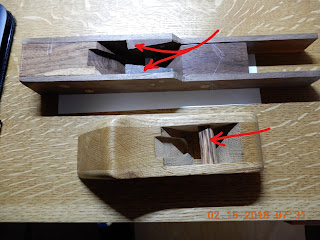We traveled to Australia three months ago and at the Immigration Museum in Melbourne one exhibit caught my eye. It was a hand plane brought by the new immigrant/craftsmen from the Old World to the new territory almost three centuries ago. There was something about its design that captivated me.
I knew I wanted to try and make one with that special feature in its construction. When I got back to our hotel I had to draw a sketch on the hotel stationery of how it would look like if I were to make one.
I made a block plane (photo below) years ago that had served me well. It had a blade from Hock Tools which I was going to use for the new version. Instead of the rounded and curved lines I was going to update the design profile with angled straight lines, taking inspiration from the stealth plane - the F-117 Nighthawk. More importantly, almost all common wooden hand planes have a cross pin against which a wedge is inserted to hold the blade. From the photo above two triangular wings serve as the cross pin. One advantage is that in this wedge system a longer lateral pressure is exerted on the blade. The weak point however is presented by the wings which can be sheared off over time as the wedge is inserted more forcefully repeatedly. Also, a higher degree of difficulty is presented in the construction of the wings. It is probably the reason it lost its popularity among tool makers then.
 |
| I chose a 40 deg cutting angle |
Tip: Drill holes the size of dowel pins to mark the location of the two sides for ease of final glue up. Double sided tapes secured them together temporarily.
 |
| Creating the wings (see photo below) |
Each wing is glued to the inside and strengthened with three 3/16 dowel pins.
 |
| I had to do a test cut just to make sure it will work even before it is completed, and sure enough it did cut. |
"Proof of the pudding is in the eating", so the block plane must perform ... and very well indeed. Because it is not a power tool the swishing sound is clearly audible as it cuts the wood fiber to the thickness of onion skin. It is so relaxing, almost therapeutic, to actually hear yourself work. This hand plane and a few others like it (shop made and restored old tools) in my shop are what makes woodworking fun, Every curled wood shaving is a reward to the senses.




















No comments:
Post a Comment